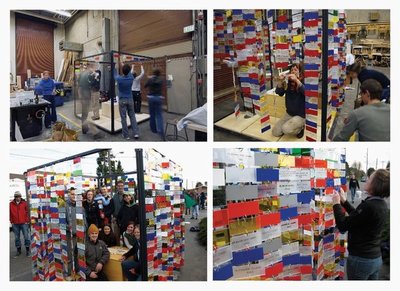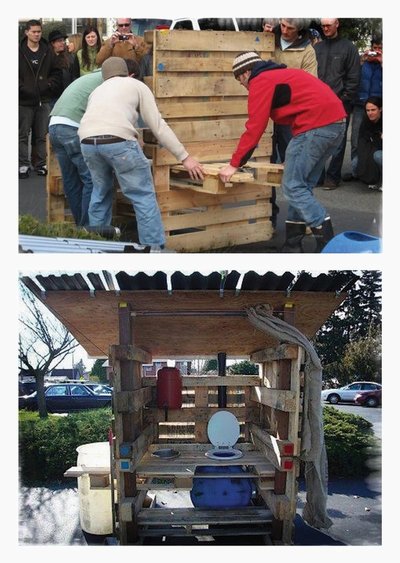April 17, 2008
UW architecture students win first prize for homeless memorial
They created both the practical and the poetic.
Along the way, several student architects from the UW also won first place in this year’s national Design Build Challenge.
Held in Seattle earlier this month, the competition resulted in two memorials that will travel around Seattle and a set of simple, easily duplicated toilets that will be given to homeless people in the area.
Travis Anderson, an architecture graduate student, helped organize this year’s Challenge. He was also part of the UW team that won first place at the 2007 Design Build competition in New Orleans.
This year’s 30 participants had 72 hours to get the assignment from their nonprofit client, design the structure, muster the materials and build the unit. And oh yes, there was no budget — team members had to scrounge building materials themselves.
The first-place winner is a 6-foot cube lined with 1,250 acrylic plaques, 270 of them bearing names and ages of Seattle homeless people who have died since 2000.
Representatives of Women’s Housing Equality and Enhancement League, or WHEEL, told the student architects they wanted a memorial to Seattle homeless who have died either outside or as the result of violence, as WHEEL and a related group, Women in Black, hold vigils after such deaths.
The plaques were donated by a local company, and with them came mirrors in the same shape. The architects decided to hang the mirrors along with the inscribed plaques as reminders of ties all people share with the homeless.
Inside the cube are thick squares of bamboo plywood flooring and a cube which serves as both a table for visitors and a container for smaller pieces of the memorial, all parts of which were donated.
In 30 minutes Friday, the UW team that designed and built the memorial mounted it in the atrium of Gould Hall. When the memorial travels, it will be “a place for homeless people to grieve as much as symbol of the problem of homelessness,” said team member Adam Amsel. On the table, Amsel placed a small, carefully finished wooden box containing a blank plaque and a marker pen for additions to the memorial, which itself awaits a name.
Randy Pellam, who lives at a tent city in Kirkland and serves on the Committee to End Homeless in King County, said the memorial makes sense because people who die homeless are often cremated, and ashes are buried in mass graves. Such people have had friends, Pellam said, and those friends grieve.
WHEEL member Anitra Freeman said the memorial makes particular sense to her group: “We were very touched. The students really put their hearts into the job, and it really touched our hearts.
The Seattle event began when organizers of last year’s challenge asked Anderson and his team to host the 2008 Design Build Challenge. They in turn formed TILT, a Seattle coalition of designers, architects and builders who use architecture to help the poor and create community awareness.
The toilets project originated with Seattle Housing and Resource Effort, or SHARE. Members told TILT that homeless people who live in open areas, away from tent cities and crowded shelters, need toilets. Their request for basic toilets also came at a time when Seattle city officials are deciding whether to remove five self-cleaning public toilets because they proved expensive to maintain and have been regularly occupied by prostitutes and illicit drug users.
For their toilet, UW architecture student Kit Kollmeyer and his team scrounged six wooden shipping pallets, fitting them together like a Lego box.They then installed a blue plastic drum they acquired from someone with a six-pack of beer, and inside the drum installed a simple composting device. They topped the box with corrugated aluminum ceiling, poked a hole in the ceiling and hung a plastic jug to catches rainwater for handwashing. A couple of burlap bags from Tully’s Coffee plant provide privacy. Total set-up time: less than five minutes. (For a short movie of construction, visit http://uwnews.org/uweek/uweekindex.asp)
Another team designed and built a toilet kit issuable to individuals or small groups. As an alternative to commercial portable toilets, it weighs only a few pounds and can be collapsed when not in use. A simple set of instructions is included with the kit.
Portable, easily constructed toilets make sense because King County regularly shuts down open encampments, citing unsanitary conditions, Pellam said. “We’re trying to find a way that the camps won’t be unsanitary.”
Five judges considered appropriateness of design and materials, and whether the students finished on time.
Steve Badanes, a UW architecture professor, served as a judge. He said the Challenge provides practical experience for student architects and a link to social justice. “Architects typically work at the top of the food chain, not in community projects,” Badanes said, “but they should take on that type of work because they have the skills to contribute a great deal.”


